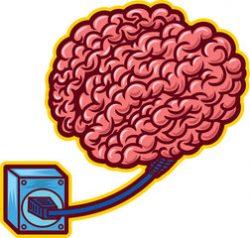Can Your Vagus Nerve Stimulate Your Business Success?
October 9, 2018 ~ Written by: W.B. “Bud” Kirchner
Approx. Read Time: 11 Minutes
Introduction
Starting with a bit of history – the vagus nerve has appeared in various contexts in earlier articles:
- Body & Brain: Part Three – Is Your Gut the Most Important Part of Your Brain?
- Body & Brain: Part Four – Gut Check: Do You Know What’s in Yours?
- Augmented Cognitive Performance: Part 1 – Hi-tech
- How Embodied is your Cognition?
Despite these previous articles, a quick summary seems in order, especially since this topic involves so much psychological and physiological context.
What is the vagus nerve?
The biology textbook definition:
The vagus nerve is one of 12 cranial nerves – it being the largest. It extends from the brainstem to the abdomen by way of multiple organs, including the heart and lungs.
Also known as cranial nerve X, the vagus forms part of the parasympathetic (involuntary) nervous system and commands unconscious body functions. Illustrative roles include keeping the heart rate constant and controlling food digestion. 80-90% of the nerve fibers in the vagus nerve are dedicated to communicating the state of your viscera up to your brain – an important bias!
How does it work:
I cite an overview via Christopher Bergland – The Neurobiology of Grace Under Pressure:
The autonomic nervous system is comprised of two polar opposite systems that create a complementary tug-of-war. The sympathetic nervous system is geared to rev you up like the gas pedal in an automobile – it thrives on adrenaline and cortisol and is part of the fight-or-flight response.
The parasympathetic nervous system is the polar opposite. The vagus nerve is command central for the function of your parasympathetic nervous system. It is geared to slow you down like the brakes on your car and uses neurotransmitters, like acetylcholine and GABA, to literally lower heart rate.
In summary, the vagus nerve serves as a bi-directional (but heavily direction biased) feedback loop between the environment within and the environment without.
As a sidebar: As with so many mind/body issues, the relevance of this mind/body link has been recognized in the East long before the West!
So much for the science lesson – now back to the Business Brain Model and therefore, the relevance to business folks.
Vagus and external environment
This section can be easily dismissed by referring back to an earlier article How Embodied is Your Cognition directed to mind/body linkage.
For those that don’t have the time or energy – here are the salient points from the earlier blog:
The essence of embodied cognition is that in addition to the mental representations originating in our minds, there are perceptual representations originating from our body via our senses.
Obviously this flies in the face of historic views that all the responsibility is with the brain. In other words, the brain is not the only influencer on behavior, including decision making, etc.
According to an article (The Scaffolded Mind: Higher mental processes are grounded in early experience of the physical world) from the European Journal of Psychology:
- “It has long been a staple of psychological theory that early life experiences significantly shape the adult’s understanding of and reactions to the social world.”
- “It is proposed that via the process of scaffolding, these early sensorimotor experiences serve as the foundation for the later development of more abstract concepts and goals. Experiments using priming methodologies reveal the extent to which these early concepts serve as the analogical basis for more abstract psychological concepts, such that we come easily and naturally to speak of close relationships, warm personalities, moral purity, and psychological pain.”
Some general considerations that illustrate the relevance of embodied cognition to business people. Having an understanding opens a plethora of “tools” both proactive and interpretive.
Excerpts from an almost endless list:
- Enhance your cognition (thinking)
- Recognize (source of) bias in others
- Using sensory experience to create copasetic meeting environment
- Sensory perceptions impact on thoughts
- Emotional tone can be influenced beyond words
- Changing body posture – change state of mind
You will note that originally, I did not identify the essential conduit transmitting information gathered about the world around us by our body (senses) to our brain.
No surprise by now – it is the vagus nerve!
Vagus and internal environment
In 1921, a German physiologist, Otto Loewi (who went on to win the Nobel Prize), made what has been described as a “happenstance” discovery in his laboratory. He discovered that when stimulated the vagus nerve caused a reduced heart rate by stimulating the release of a substance he termed “Vagusstoff” (German: “Vagus Substance”). The “vagus substance” was later identified as acetylcholine and became the first neurotransmitter identified by scientists.
Vagusstuff is literally a “tranquilizer” that you can self-administer if you take a few deep breaths combined with long exhales which is obviously a simple (manual) vagus nerve stimulation. Electrical stimulation of the vagus nerve, called vagus nerve stimulation (VNS), is so powerful it is sometimes used to treat people with epilepsy or depression.
I have in my readings seen reference to stimulation of the vagus nerve having an impact on the ability to consolidate memories – presumably involving the amygdala.
In my mind I envision 3 stages of vagus:
- “Resting” vagus
- Healthy vagal tone is reflected by a slight increase of heart rate upon inhalation, and a decrease of heart rate upon exhalation.
- In other words the vagus maintains inner-tranquility so you can “rest-and-digest” (in contrast to “fight or flight”) so you can be prepared if “danger” challenges your safe mode.
- “Irritated” vagus
- This can be precipitated by circumstances such as you psyche yourself out before an important event, feel overwhelmed or threatened, or insecure. Your vagus nerve interprets that you are in fight/flight mode which exacerbates these negative responses.
- You experience physical symptoms typical of anxiety: racing heart, sweaty palms, dry mouth, and upset stomach.
- “Stimulated” vagus
- Electricity delivered to the vagus nerve in just the right intensity and at precise intervals could reproduce a drug’s therapeutic reaction.
- More about this in balance of article.
Enhancing the vagus
Hopefully by now you can see the value in enhancing the vagus effect.
The 2013 study by Barbara Fredrickson and Bethany Kok of the University of North Carolina at Chapel Hill, “How Positive Emotions Build Physical Health: Perceived Positive Social Connections Account for the Upward Spiral Between Positive Emotions and Vagal Tone,” was published in Psychological Science. This groundbreaking research honed in on the vagus nerve and discovered that a feedback loop between positive emotions, physical health, and positive social connections led to high vagal tone index.
According to Christopher Bergland:
“From a simplified evolutionary perspective, one could speculate that our ancestors relied on the sympathetic nervous system to kickstart neurobiological responses needed to hunt, gather, and ward off enemies. Conversely, the parasympathetic nervous system probably fortified our innate drive to nurture close-knit human bonds, procreate, and build survival-based cooperative and supportive communities.” (A Vagus Nerve Survival Guide to Combat Fight-or-Flight Urges)
In this article, Bergland proposed what he called “the vagus nerve survival guide” (I will only flesh out one of these but encourage you to research the balance):
- Diaphragmatic Breathing Exercises
- Tonic Levels of Daily Physical Activity
- Face-to-Face Social Connectedness
- Narrative Expressive Journaling
- Gutsy Third Person Self-Talk
- Sense of Awe to Promote Small Self
- Upward Spiral via Loving-Kindness Meditation
- Superfluidity and Secular Transcendent Ecstasy
- Volunteering and Altruistic Generativity
- Tracing the Genesis of The Vagus Nerve Survival Guide
The simple protocol for a diaphragmatic breathing pattern:
- Inhale through the nose for a count of four, and concentrate on pushing the air into the belly instead of the chest.
- Hold the breath for seven seconds.
- Exhale slowly through the mouth for a count of eight.
Conclusion
The vagus nerve is an extraordinarily important component of the mind/body aspect. As such, it is relevant to emotions, behavior and performance. Fortunately, various methods of stimulation can enhance performance of the vagus nerve.
Bibliography
- Michael Behar – Can the Nervous System Be Hacked?
- Christopher Bergland – Vagus Nerve Stimulation Helps Treatment-Resistant Depression
- Christopher Bergland – The Neurobiology of Grace Under Pressure
- Christopher Bergland – A Vagus Nerve Survival Guide to Combat Fight-or-Flight Urges
- Kavita Daswani – 4 deep breathing tips that can change your life
- Douglas Fox – Can Zapping the Vagus Nerve Jump-Start Immunity?
- healthlines.com – BodyMaps
Relevant Business Brain Model articles
- Body & Brain: Part Three – Is Your Gut the Most Important Part of Your Brain?
- Body & Brain: Part Four – Gut Check: Do You Know What’s in Yours?
- Augmented Cognitive Performance: Part 1 – Hi-tech
- How Embodied is your Cognition?
About the Author: W.B. “Bud” Kirchner is a serial entrepreneur and philanthropist with more than 50 years of business success. He is not a scientist or an academic but he does have a diversified exposure to neuroscience, psychology and related cognitive sciences. The ideas he expresses here are business-angled expansions of other people’s ideas, so when possible, he will link to the original reference.



